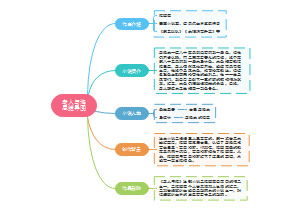导图社区 英语国家概况chapter12
- 741
- 13
- 5
- 举报
英语国家概况chapter12
这是一篇关于英语国家概况chapter12的思维导图,需要学习英语国家概况chapter12的小伙伴可以点赞加收藏
编辑于2022-12-03 23:24:09 贵州- 英语国家概况
- 英语国家
- 国家概况chapter5
A national festival on November 5 ? Historical event celebrated: In November 1605, the gunpowder plot took place in which some Catholics plotted to blow up the English Parliament and...
- 国家概况chapter3
Chapter 3 Government and the Commonwealth 1 I. Constitution • Britain is both a parliamentary democracy (议会民主制) and a constitutional monarchy. The King or Queen is the head of...
- 国家概况chapter13
这是一篇关于国家概况chapter13的思维导图,想要学习国家概况chapter13的小伙伴可以点赞加收藏
英语国家概况chapter12
社区模板帮助中心,点此进入>>
- 国家概况chapter5
A national festival on November 5 ? Historical event celebrated: In November 1605, the gunpowder plot took place in which some Catholics plotted to blow up the English Parliament and...
- 国家概况chapter3
Chapter 3 Government and the Commonwealth 1 I. Constitution • Britain is both a parliamentary democracy (议会民主制) and a constitutional monarchy. The King or Queen is the head of...
- 国家概况chapter13
这是一篇关于国家概况chapter13的思维导图,想要学习国家概况chapter13的小伙伴可以点赞加收藏
- 相似推荐
- 大纲
Education, Media and Holidays
Education
Ideals of American Education
As many people as possible should have access to as much education as they want
Producing a society of literacy and local control
Producing a society of literacy and local control
Emphasis on the basic nature of knowledge and learning
Education is both an individual benefit and a social necessity.
Every American has the right and obligation to become educated.
Educational System
Elementary and Secondary Education
Elementary and secondary education—the basis of public education, free and compulsory, 12 grades
One academic year—from September through June
Different divisions of school systems:
Elementary education
Class size—20 to 30 students
Secondary education
Two stages: junior high school and senior high school
Courses: more specialized—English, social studies, algebra, geometry, etc.
Nine periods for a day:
five for academic subjects one for physical education a lunch period two study periods
Scholastic Aptitude Test (SAT)
a standardized test for most college admissions in the United States. intended to assess a student's readiness for college. first introduced in 1926. seven times a year in the United States. Possible scores range from 600 to 2400, combining test results from three 800-point sections (Mathematics, Critical Reading, and Writing).
Higher Education
The beginning of higher education—the founding of Harvard College in 1636
a big enterprise with a complex system
Four categories of institutions
the university the four-year undergraduate institution—the college technical training institution two-year community college
College & University
Location of institutions
New York—308 institutions California—299 institutions Nevada and Wyoming—only nine institutions each
The variety of subjects
fine arts and practical, career-oriented fields
The variety of institutions
large, comprehensive universities and small traditional liberal arts colleges
Factors for students’ personal preferences
size, academic quality, location reputation of the faculty and department
The Board
The board of trustees (理事)—carrying out administration of colleges and universities
Composed primarily of laymen (非专业人士)
Legal body, responsible for the institution
Responsibilities:
choosing the president; establishing policies for administrators and faculty; approving the budget; the purchase and sale of real estate and other major property items, etc.
College Life
An academic year—nine months
Students’ organizations—clubs and activities
Famous Universities
Ivy League—including eight universities (Brown, Columbia, Cornell, Dartmouth, Harvard, Pennsylvania, Princeton, and Yale)
Harvard University
The oldest institution of higher learning in America
Yale University
Founded in 1701 as the Collegiate School (联合学院) in Killingworth, Connecticut
MIT
MIT—Massachusetts Institute of Technology
Established in 1861 in Boston, moved to Cambridge in 1916
Institute of developing advanced administrative talents and scientific and technological talents
Multicultural Education
Schools teach the experiences and values of many ethnic cultures
Cultural pluralism—organizing principle of education
To solve problems and reach conclusions by trial and error
Culture influences classroom communication
Critical thinking, judgmental questioning, active participation, and independent and participatory learning—expected and encouraged
International Ss benefit from and contribute to the American educational system
Media
Newspapers
More daily newspapers than other countries
Influential Newspapers
The New York Times
established in 1851, number one for editorial quality and news coverage
associated with the Rockefeller Interest Group and financial field
sold especially to the upper or upper-middle class
reputation for its serious attitude and great bulk (数量、容量)
The New York Times
established in 1851, number one for editorial quality and news coverage
The Los Angeles Times
established in 1881
third most influential
second biggest newspaper
Television and Broadcast
No government-owned television network
Major radio and TV networks
the Columbia Broadcasting System (CBS) the National Broadcasting System (NBS) the American Broadcasting System (ABS)
Commercials in TV—advertisements
One channel with no commercials
CNN
cable TV network founded in 1980 by Ted Turner a division of the Turner Broadcasting System, owned by Time Warner based in Atlanta with four channels provides programs like World Report, World Business, World Sport, World weather, World Beat (世界音乐), Hotspots (热点问题), Insight(透视), and Q & A (Question and Answer) 24-hour news coverage
VOA (Voice of America)
the most famous radio station for the expansion of propaganda to foreign countries supported and organized by the government, in Washington D.C. originally established for war information, now under the leadership of the American International Communication Bureau sending news to the world in more than 40 languages 24 hours a day
Holidays and Festivals
Thanksgiving
The 4th Thursday in November
most important holiday apart from Christmas
Schools, offices and most businesses close the whole weekend—a vacation
Traditional dinner
turkey (filled with stuffing or dressing) sweet potatoes (also called yams) Cranberries made into a kind of sauce or jelly
Independence Day
The national day—the 4th of July
On this day in 1776, the Continental Congress adopted The Declaration of Independence.
Celebrations
the army—firing a thirteen-gun salute ceremonies—parades, official speeches, historic monument visits, out-door stage shows, dancing parties, boat races and firework displays









